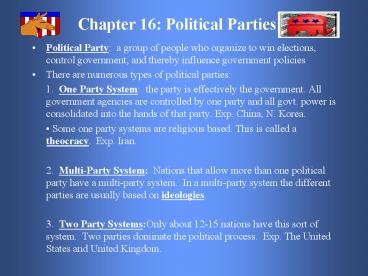Chapter 16: Political Parties - PowerPoint PPT Presentation
Title:
Chapter 16: Political Parties
Description:
Chapter 16: Political Parties Political Party: a group of people who organize to win elections, control government, and thereby influence government policies – PowerPoint PPT presentation
Number of Views:495
Avg rating:3.0/5.0
Title: Chapter 16: Political Parties
1
Chapter 16 Political Parties
- Political Party a group of people who organize
to win elections, control government, and thereby
influence government policies - There are numerous types of political parties
- 1. One Party System the party is effectively
the government. All government agencies are
controlled by one party and all govt. power is
consolidated into the hands of that party. Exp.
China, N. Korea. - Some one party systems are religious based.
This is called a theocracy. Exp. Iran. - 2. Multi-Party System Nations that allow more
than one political party have a multi-party
system. In a multi-party system the different
parties are usually based on ideologies. - 3. Two Party SystemsOnly about 12-15 nations
have this sort of system. Two parties dominate
the political process. Exp. The United States
and United Kingdom.
2
- Growth of American Parties
- Americas two party system grew from our
British colonial origins of the Whig party and
the Tory party. - The founding fathers initially factions
because they felt there were harmful to national
unity. President Washington warned against the
rise of political partied in 1797. - There were initially two major American
Political Parties - 1. Federalist
- 2. Democratic-Republican
- The Federalist party splintered around 1814,
and the Democratic-Republican Party became the
Democratic Party. - 1828, the Democratic Party split in half over
regional issues and Andrew Jackson. One half
split into the Whig party. - By the time of the Civil War the current two
party system that we have today came into being. - 1. Democratic Party
- 2. Republican Party
3
- The Republican Party began as a third party in
1856, but Abraham Lincoln was elected President
due to a split in the Democratic Party over
slavery. - 1860 Election
- Candidate Party Electoral
Popular - Abraham Lincoln, Republican 180
1,867,198 - J. C. Breckinridge, Democrat 72
854,248 - John Bell, Constitutional Union 39
591,658 - Stephen A. Douglas, Democrat 12
1,379,434 - Parties since the Great Depression and WWII
- 1932 Franklin D. Roosevelt won the Presidency,
and he and his Vice President Harry Truman
controlled the White House for 24 years. The
Democratic Party controlled one or both Houses of
Congress until 1994.
4
- The Role of Minor Parties
- The two major parties dominate American
politics but minor parties will sometimes make a
difference in an election or on an issue - Third Party any party other than the major two
parties. - There are different types of third parties
- 1. Single Issue Parties focuses exclusively
on one major social, economic, or moral issue.
Single Issue parties generally fade away after
the issue is resolved or fades from public
interest. Exp. 1840s Liberty Party (abolition of
slavery) - 2. Ideological Party Focuses on overall
changes in society rather than a single issue.
Exp. The Socialist Labor Party or Communist Party
USA. - 3. Splinter Party splits away from one of the
major parties because of some disagreement. Exp.
1912 Theodore Roosevelt broke away from the GOP
to form the Progressive, or Bull Moose Party.
Splinter parties typically fade away if they can
not gain voters attention.
5
- The Impact of Third Parties
- Although third parties rarely win elections
they can influence the outcome of elections.
Exp. Teddy Roosevelts Bull Moose Party took
enough votes from the GOP that Democrat Woodrow
Wilson was elected President. (chart pg. 456) - Obstacles to Third Parties
- Not automatically on ballot
- U.S. elections are based on single-member
districts which hurt third party candidates. - Single-member Districts electoral district
where regardless of how many candidates there
are, only one will win. winner take all. - Proportional Representation several officials
are elected to represent voters in an area.
Offices are filled in proportion to how many
votes a party receives.
6
- Local Party Organization
- Precinct basic local party unit. A voting
district ranging from a few voters to more than
1000. - Precinct Captain volunteer who organizes party
workers to distribute information about the
partys candidates. - Ward several adjoining precincts.
- Each county party will select a county
chairperson. The chairperson is the head of the
party in the county and holds rank in the state
party organization. - County and local political parties rely on
volunteers to make them work.
7
Section 3 Nominating Candidates
- How Candidates are Selected
- caucus
- nominating convention
- Primary Conventions
- Direct Primary
- Closed Primary
- Open Primary































